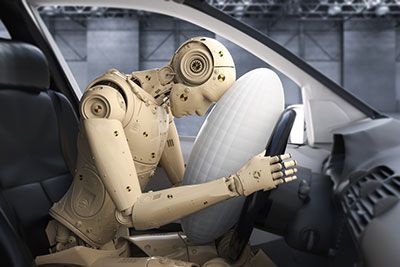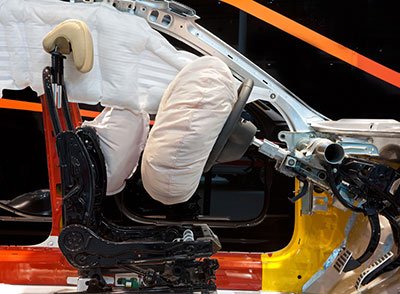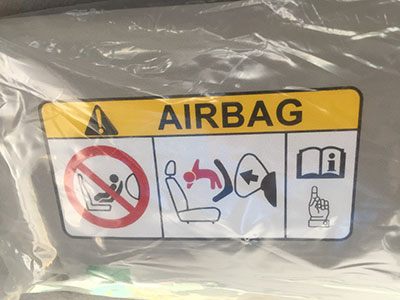Since their initial launch in the 1980s, airbags have saved thousands of lives and vehicle occupants during crashes.
However, air bags and car seat safety do not work as expected. Instead of offering protection,
airbags' rapid deployment can injure a tiny passenger in the car seat.
We teach you about air bags and car seat safety and take you through a detailed guide on keeping the child safe in the car seat.
More...
Take away key points:
How Do Air Bags Work?

Air bags look like nylon bags packed into the steering wheel and dashboard.
Every vehicle with an air bags system will include accelerometers. Accelerometers detect the rate of deceleration and wheater an impact of a crash has occurred. The entire system of accelerometers is hooked to an ignition device that produces nitrogen gas through a chemical reaction. In case of a car accident, nitrogen gas fills the air bags.
The air bag deflates as soon as the passenger seat is pressed against the air bag. Then, the sensors which deploy an airbag will determine whether the air bag should open under higher or lower force. As a result, air bags rapidly deploy up to 200 mph, while the entire inflation process happens in only a fourth hundred of a second.
How effective are airbags?
Airbags are known as supplementary restraint systems. However, the air bag's supplementary quality does not help them to replace seat belts. Instead, an air bag works successfully only when combined with the seat belt.
The side impact car crashes and fatal outcomes were decreased to 43% in vehicles with side impact airbags and curtain airbags, according to an NHTSA report. Similarly, front air bags can reduce driver and passenger death by 63%.
History Behind Air Bags
The history of airbags dates back to 1953, when John Hetrick's family car accident urged him to create a patent for a vehicle safety cushion, later known as an airbag. However, due to the lack of technology that would use sensors to activate air bags, Allen Breed started creating the very first crash sensor.
In 1970, car manufacturers introduced front passenger seat air bags. Once the law for mandatory seat belt presence in vehicles was at power, many drivers and passengers refused to use seat belts. Vehicle occupants believed that air bags were sufficient safety features.
Both Ford and General Motors included air bags in a few of their exclusive models. However, the manufacturers saw air bags as impractical. Due to consumer car safety, car manufacturers began designing vehicles with air bags again in the 1980s. During the 1980s period, air bags were not an optional feature. In 1998, all new cars were designed with a mandatory airbag.
Modernized Air Bag Design
The first design of airbags, as well as their deployment, differed significantly from the modernized airbag design of today.
The newly designed airbag system will work according to sensor information. The sensors indicate the gravity of the car crash and the passenger's size and position in the vehicle seat.
Advanced air bags are also called dual-stage air bags. The dual stage air bags detect the speed they need to deploy to keep the passengers safe and minimize the risk of serious injury.
Advanced air bags design was included in the following form:
Why Are Air Bags Dangerous for Children?

Air bags are designed to protect a fully grown adult.
A rear-facing car seat should never be installed in the front passenger seat due to the risk of air bag deployment. The rapid deployment can cause severe injuries to the child in the car seat and children younger than 13 years old.
All children passengers younger than 13 should ride in the rear seat with the proper child restraint. This is because the young child's body and bones are still developing, which is why they are at higher risk of suffering severe head trauma in an accident.
We mentioned that nitrogen gas fills the air bag module and forcefully ejects the air bag from the front seat dashboard. In addition, if the child safety seats are installed in the passenger seat, the airbag will deploy directly into the child's head, causing trauma and even infant death.
Front seat airbags can cause severe trauma to children even if the vehicle moves at low speed. If your vehicle does include front seat air bags, ensure young children and car seats are restrained and installed in the back seat.
Vehicles with no rear seats are unsuitable for traveling with children and cannot keep a child safe even if the child is restrained in its car seat.
Are Side Air Bags Safe Near a Car Seat?
By now, we know that front seat airbags are not safe for children, but, are side airbags safe near a car seat?
Many modern vehicles will include a side air bag in the form of:
- Door pillar
- Forward-facing frontal air bags
- Head air-bags or inflatable tubular structures beneficial for side impact protection
While some vehicles include side air bags in the rear seat, a few cars will also have side air bags in the back seat. A side air bag is smaller than a regular rear seat frontal air bags, but it can still cause trauma and injury if the child's head is too close to the window.
Typically, a side airbag injury risk to the child in a car seat is lower if the child is correctly restrained with a 5-point harness. However, you should still ensure the child restraint seat is not leaning against the door and is properly positioned.
Curtain airbags that protect against head injury also show minimal injury risk to a restrained child.
For optimal safety, choosing a child car seat with added side impact protection is best.
Takata Air Bag Recalls
Tens of millions of U.S vehicles were designed with Takata air bags under recall. The Takata airbags were inspected after faulty non-azide driver inflators, which caused the airbags to explode or not even deploy.
A total of 19 people have died during car accidents due to defective Takata air bags, according to the National Highway Traffic Safety Administration.
By visiting this link, you can quickly check if your vehicle is using the Takata air bags. Then, contact your local dealer to fix, repair, and replace the air bags.
Car Seat & Air Bag Safety Tips
1. Appropriate car seats
All children under two are safest in their rear-facing seat with a proper five-point harness. A rear-facing seat should be installed behind the driver's seat or in the center of the back seat.
Once the child fully outgrows the weight and height limit of rear-facing seats, a child should be restrained in a forward-facing car seat. Children between the ages of 4-12 can ride in a booster seat if they are mature enough for seat belt use. Even though a booster seat can be used as early as four, ensure your child is ready to ride in a seat with no harness.
Older children aged 13 can legally ride in the front seat while restrained with a shoulder belt and a lap belt. However, front seats and front air bags are designed to protect adults, so before your child switches to the front seat, they must be prepared to fit in the seat.
You can check whether the child is ready for the front seat by checking the lap and shoulder belt fit. If the shoulder belt rides too high on the neck and the lap belt goes over the stomach, a child should remain in a booster for a little longer.
2. Position of the car seats
Rear-facing car seats and air bags are a dangerous combination! Always ensure rear-facing and forward-facing car seats are installed in the back of the vehicle.
Ensure the rear-facing car seat is not installed too close to the active side-impact air bags. Child passengers in booster seats should also not lean against the side airbags.
3. On/off switches

Vehicles without a back seat (trucks & sports cars) must have an on/off air bag switch. If a child passenger must ride in the front sitting position, ensure the car airbags and the passenger air bag are turned off.
4. Buying a new car seat
If you are purchasing a new child car seat, ensure the child restraints are fitted for the airbags in your vehicle.
FAQs
Can children be seated in an airbag?
Children younger than 13 should never be seated in front of the air bag. The air bags work by the fast deployment of nitrogen gas, which can injure kids in their car seats by causing head and neck trauma.
Are side airbags safe for car seats?
No, airbags are not safe for kids in car seats. Air bags are designed to protect a grown adult. A child's fragile body will not endure the forceful impact of an air bag. Children passengers younger than 13 should always ride in the back of the vehicle with a good restraint harness.
Can a child sit in the front seat of a car without airbags?
A child passenger can sit in the front seat of a car without airbags if he is older than 13 years and is physically mature enough for a seat belt. However, air bags should always be active, while the child needs to be correctly restrained with a seat belt for optimal car seat safety.
Final Words
When traveling with children, you must ensure they are safe in their car seats. This means a child should be properly restrained with a car seat in a good seating position. Although air bags saved millions of vehicle occupants, they still oppose a large threat to children in car seats.
Remember to ensure air bags and car seat safety by always installing the car seat in the back of the vehicle, away from the air bags.
